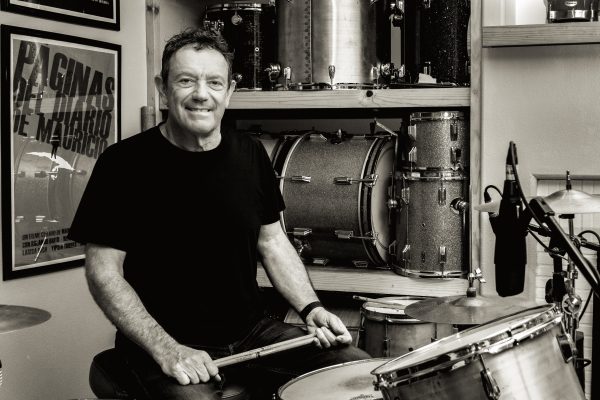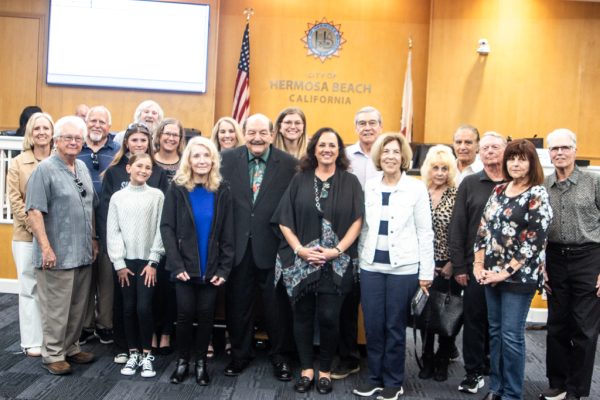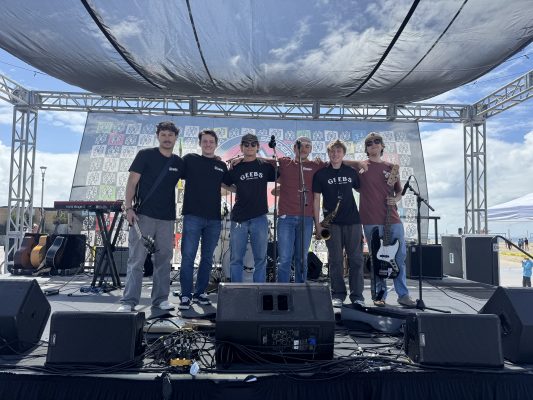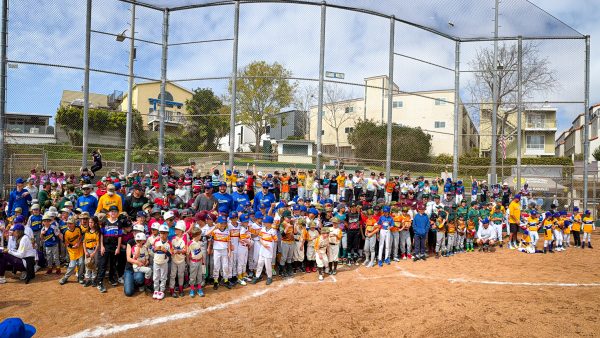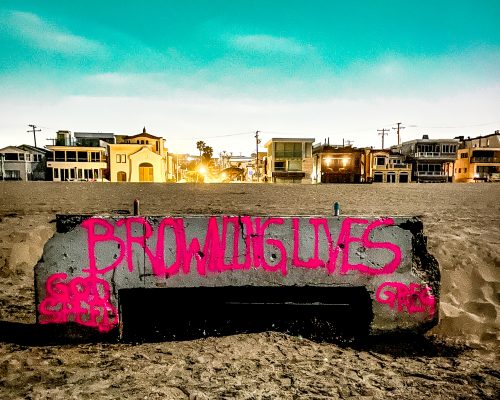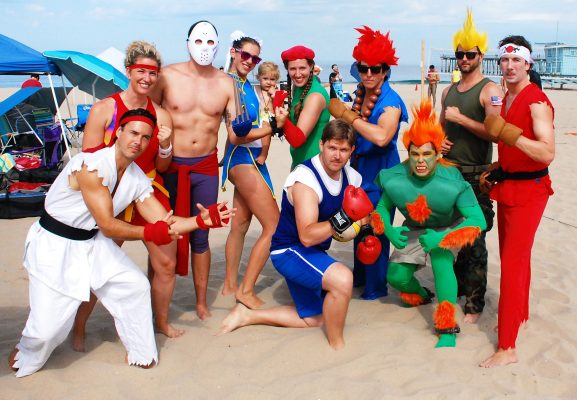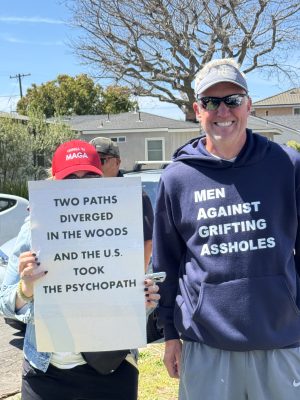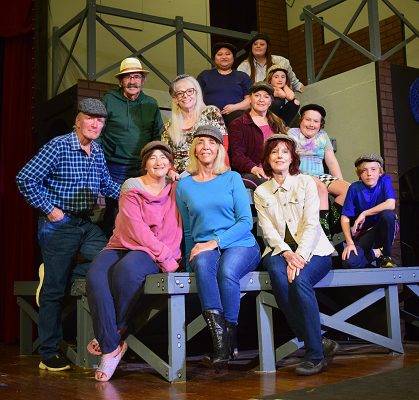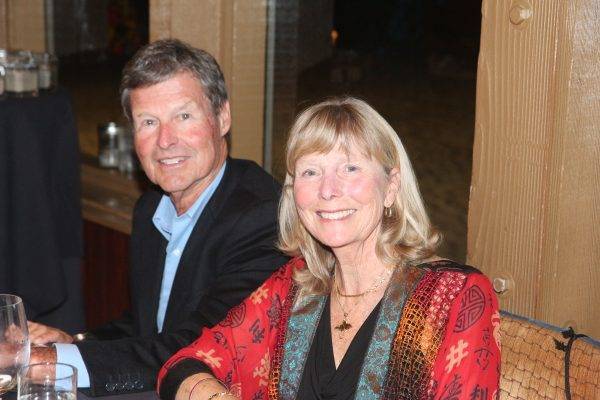by Mark McDermott
Imagine a scenario that goes something like this: thousands of people are gathered at the Manhattan Beach Pier for an event, and a lunatic, armed with explosives, has decided this would be the perfect place to make a violent statement.
Our hero in this story isn’t who you might expect her to be. She’s blonde, and she’s a labrador. Her name is K9 Rio, and as she weaves through the crowd, she alerts to the scent of explosives, and suddenly her friendly, tail-wagging demeanor is gone. She’s on the job. She pulls fiercely at her leash, and leads her handler, Officer Kyle McCammon, straight to the source of the scent. Within moments, a dozen of MBPD’s finest are surrounding, and arresting, the would-be perpetrator. A tragedy is averted.
This is a scenario that will hopefully never happen. But K9 Rio, MBPD’s first-ever bomb-detection dog, was added to the force in February just to make sure no such tragedy happens. She also happens to be MBPD’s first labrador.
McCammon, a ten year police veteran, said that bomb detection dogs — most who, like K9 Rio, can also detect ammunition — are being deployed by more and more police departments due to the increasing frequency of bomb threats.
“More departments in the area are utilizing straight detection dogs, meaning sole purpose dogs, used just for detection, whether it be just for guns or narcotics or explosives or a combination of,” McCammon said.
This trend is occurring nationally due to heightened concerns after the bombing of the Boston Marathon over a decade ago and a spike in domestic terrorist attacks over the last decade. Regionally, law enforcement agencies are preparing for the arrival of the Olympics in Los Angeles in 2028.
McCammon said bomb dogs were already in use in Manhattan Beach prior to MBPD obtaining Rio.
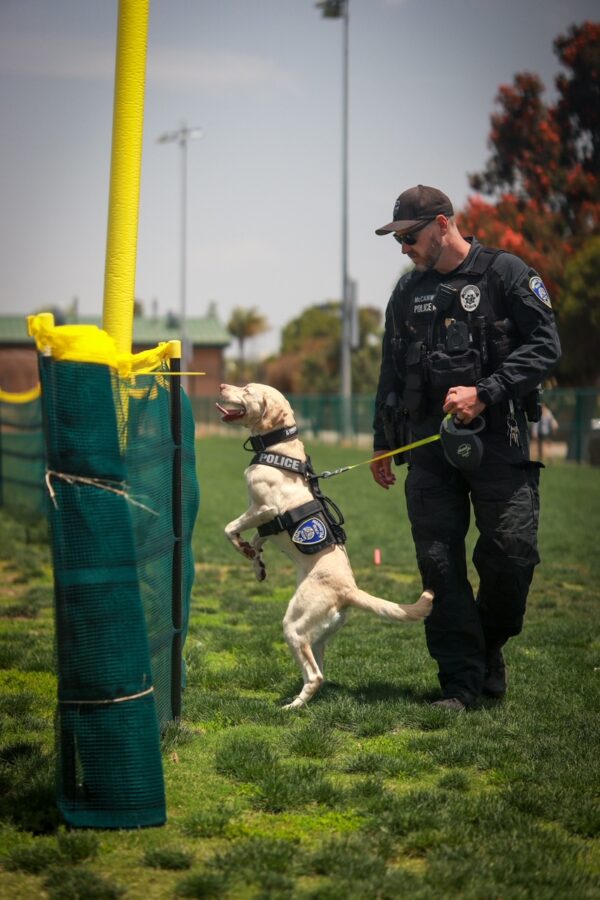
“We were already asking other cities, such as Inglewood and Hermosa, to come assist when we would have our fireworks show and big events like that, to run dogs through prior to letting citizens in,” he said. “As for checking explosives, I think that’s the way most large events are going now, especially after you have the Boston Marathon bombing and things like that, where it possibly could have been prevented with some pre-checks before the public is let in or just having a bomb dog run through while the public is there. So that, coupled with the Olympics coming to LA, with so many venues across the area — I think a lot of police departments are trying to gear up and cross-train with each other so we can utilize these resources.”
MBPD deploys two K9 units. In addition to McCammon and Rio, Officer Brian Cobian and his K-9 partner Troy, a Dutch shepherd added to the force in 2023 who specializes in firearms detection and criminal apprehension (also, tellingly, known as “a bite dog” in the K-9 world). Last December, the legendary K-9 Koa retired; in partnership with his handler, Officer Dave Gibbons, K-9 Koa was deployed in 166 high risk incidents, resulting in 64 arrests, 2,500 pounds of illegal drugs seized, and the seizure of $1.1 million in narcotic-related sales money.
Those are big paws to fill, but K-9 Troy is off to a strong start. In just 18 months on the force, K-9 Troy has already found more than 70 weapons, and his mere presence at several incidents has averted conflict and led to quick surrenders by fleeing suspects. Cobian said this has made Troy very popular among his colleagues.
“People sometimes aren’t so scared of us, but they are scared of him,” he said. “They are more willing to listen to him when he becomes more vocal, whether it’s because he can run fast, because he can bark, or because he is strong — whatever it is, people tend to listen to him more than they listen to us.”
MBPD Lt. Steve Kitsios, who oversees the K-9 program, said that in addition to the practical, on-the-ground effectiveness of police dogs, their presence is also a preventative measure.
“It’s just having that sense of security that we have this tool,” Kitsios said. “We all love dogs, but these aren’t pets. These are tools for the City and the department which, particularly at these special events, give us a sense of comfort and another layer of safety….But these dogs also help save officers lives by doing searches in backyards, searching vehicles in felony stops, and putting their lives on the line first before the officers. They provide a first line of safety for our officers before entering a danger zone.”
MBPD has had a K-9 program since 1980. The program was bolstered in 2018 with the establishment of the Manhattan Beach Police K-9 Foundation, a non-profit founded in order to help fund the many peripheral costs associated with police dogs. The Foundation helps pay for additional training for the dogs and their handlers, the acquisition of agility equipment for the dogs, and for the long-term care of K-9s when their active duty days are done. K-9 handlers usually keep their dogs after retirement, and the foundation helps support the dogs the rest of their lives, covering medical and even funeral costs.
Two years ago, at the MB K-9 Foundation’s signature fundraising event, the downtown car show, something unprecedented happened. A private citizen was so impressed with the K-9 program that he wrote a check on the spot earmarked for the acquisition of another dog.
“The citizen just said, ‘You guys should have another dog,’ not specific to what kind of dog to get with the donation,” McCammon said. “But just that we should have more dogs in the city.”
At the time, McCammon had not yet served as a K-9 handler but had volunteered and was selected to do so. The department decided to find a bomb detection dog, and McCammon went to assess different candidates at Gold Coast K-9, a police and service dog provider and training facility in Moorpark which MBPD K-9 has worked with in the past. The final two candidates McCammon looked at were a Belgian Malinois and Rio the labrador.
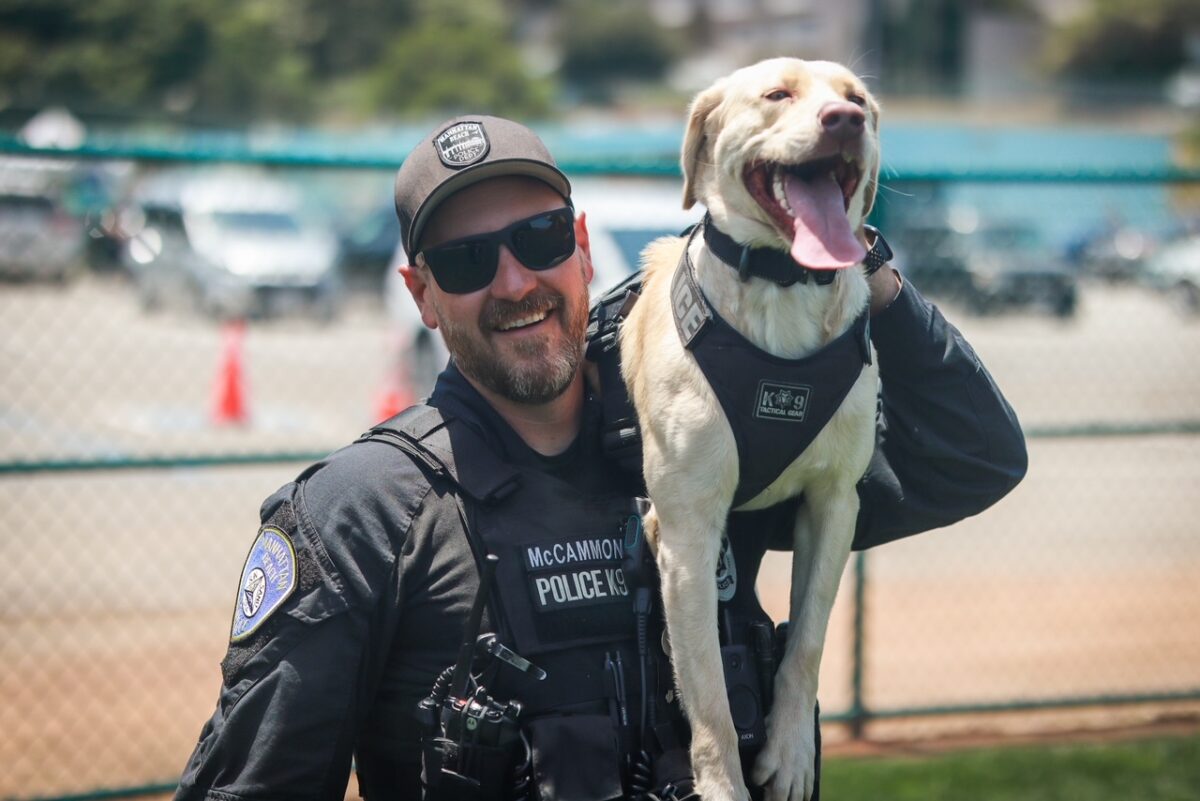
“Rio definitely outperformed the other dog. She did very well,” McCammon said. “It was raining that day, and she wasn’t bothered by it being a bit sideways outside. She just had a real happy disposition and was really excited to do the work.”
She came from a police family. Her father was a K-9 for the LA County’s Sheriff’s Department.
“Rio definitely comes from a pedigree of dogs that are being utilized out in the field for bomb detection,” McCammon said.
All K-9s are selected while still puppies for their athleticism and disposition, and then trained to build on these inherent gifts.
“She’s on about 14 different odors she can recognize, which includes many explosive ordinance and firearm components, meaning gunpowder, black powder, and gun oil,” McCammon said. “Different ways to recognize firearms and explosives.”
All dogs perceive the world most fundamentally through their noses, but bomb detection dogs even more so. According to “Being a Dog: Following a Dog into a World of Smell”, a book about canine olfactory abilities by author Alexandra Horowitz, an average dog can detect one milligram of a selected odor among 100 million cubic meters of air.
“You’ll notice your spouse’s smelly socks the moment after they are removed in the bedroom: that’s around forty cubic meters of very socky-smelling air,” Horowitz writes. “The dog knows if someone’s removed his socks in a room bigger than the gargantuan vehicle assembly building at NASA’s Kennedy Space Center in Florida, made to put the space shuttles together. Any dog in the nearly four million cubic meters of the Space Center would be alert to sweaty astronauts.”
But bomb dogs are even more gifted. “Explosive detection dogs smell as little as a picogram — a trillionth of a gram — of TNT or other explosive,” Horowitz writes.
Rio was born with that gift. But what McCammon saw in her was something else that cannot be trained.
“A lot of them have the nose for it, but maybe not the drive to want to work and do it,” he said. “So that’s a big thing that we are looking for when we are picking dogs — we want them to have a strong drive to work. We don’t want to be dragging them. Because all of this stuff, to them, is a game, and they should be excited about it … .It’s that drive that you can’t train them for. Rio has it.”
Rio’s other ace in the hole as a bomb dog is her natural gregariousness. People don’t think of labradors as police dogs, in part because they aren’t scary. But what this means in terms of detection work is they are comfortable in crowds.
“Rio is trained to recognize moving odor, mobile odor,” McCammon said. “So we can work her in a crowd. Yes, she’s still a dog, but she’s obviously very comfortable around people, and vice versa. We don’t mind her walking through a crowd, whereas if we’re using a bite dog, a Malinois or something, I would have my reservations about that.”
K-9 Troy is a bite dog, and has put this attribute to very good use on behalf of local public safety. He weighs 85 pounds and moves with the agility, speed, and grace of the elite athlete that he is. His handler, Cobian, said that the veterinarian who looks after Troy describes him as “a Ferrari.”
“He’s fast, and he’s very, very strong,” Cobian said. “I mean, when he’s in [high alert] drive, he could drag me to the ground if he wanted to.”
Both MBPD K-9s are frequently employed in mutual assistance calls in surrounding jurisdictions. For example, the recently opened Inuit Center in Inglewood, where the Clippers play, requires far more bomb detection dogs than any one agency could provide, so departments send their K-9 units to games and other events. This means that MBPD benefits from reciprocation from other agencies’ K-9 units at its own events. But it also provides more training opportunities for Rio and Troy, who are both still young K-9s if not quite rookies any longer.
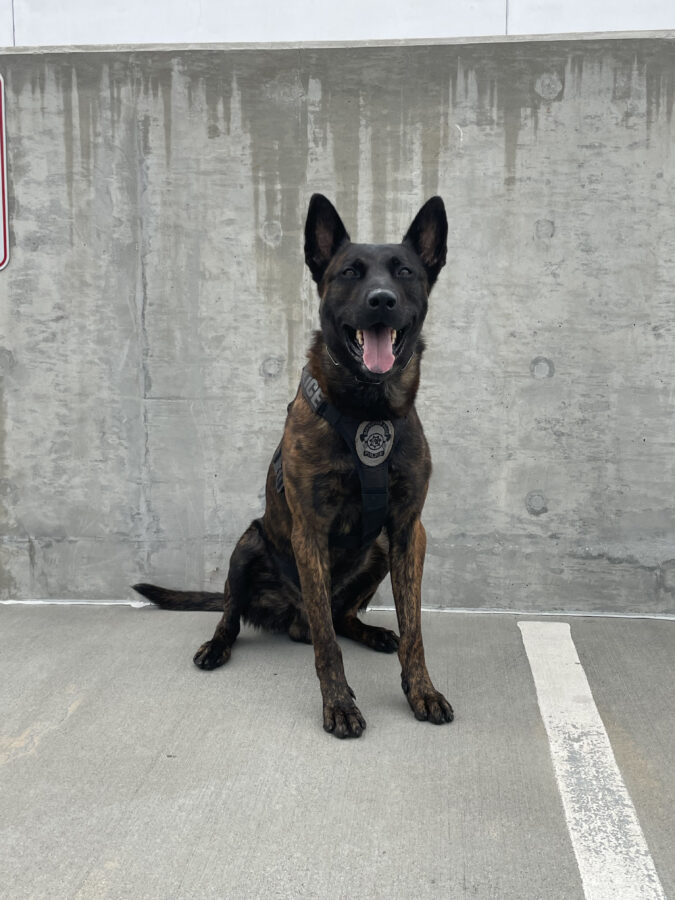
Cobian said all this experience has contributed to Troy’s remarkable success so early in his career.
“We’ve assisted approximately 30 different agencies,” he said. “I’m lucky that my direct supervisors, my sergeant and my lieutenant, have allowed us to assist those cities. That has meant Troy has been getting a lot of experience in a relatively short amount of time.”
A few months ago, Cobian and Troy went on a call to Hawthorne after a shooting occurred.
“They knew the shooting happened in one intersection,” Cobian recalled. “They caught the suspect at another intersection. He had no gun, so they knew it was somewhere on the street, they just didn’t know where it was.”
The MBPD K-9 team arrived on the scene and quickly went to work. Troy hopped out of the patrol car, Cobian called him to heel, then gave the command to search.
“And I just start watching him, and he alerts,” Cobian said. “I remember thinking, ‘Holy cow, he alerted.’ And we look up, and there the gun is, kind of behind a bush. It was pretty cool, even for the Hawthorne officers, to see how it works for a dog.”
Another time, they were called to Southgate, to help with parolee compliance checks.
“We ended up going into a house, and he alerted on a door that was locked,” Cobian said. “We were able to get the door open, and we were able to find a rifle and two hand guns. We were able to arrest the person at the house, because he was a prohibited person who was a felon. They were able to arrest him for being in possession of firearms.”
But of course much of Troy’s work takes place in Manhattan Beach. In one incident, several officers were in pursuit of a burglary suspect, who’d abandoned his car and run into a neighborhood. Officers set up a containment area and were searching house to house when the suspect came tearing out from a house right by where Cobian and Troy were stationed. The suspect took off running, but did so in the direction of Sepulveda, which was only a few blocks away. Cobian wasn’t going to release Troy because he feared he might get run over on Sepulveda, so he ran alongside him with a longline leash. But he warned the suspect that he would turn the dog loose.
“Stop, police,” he said. “If you don’t stop, I’ll use the dog.”
Troy was barking furiously, and the sight the suspect saw when he looked over his shoulder — a big, sleek, and very agitated Dutch shepherd, utterly focused on him — must have been a terrifying thing to behold.
“Troy, he’s getting closer and closer. The guy is running pretty fast, and we’re catching up,” Cobian recalled. “Troy is pulling me, pulling me. And as we are getting up to him, he turned, ‘Okay, okay! Don’t let the dog bite me!’ If Troy wasn’t there, he would have just kept running….But because Troy was there, he didn’t put up a fight, and nobody got hurt. Which is a big reason we use the dog, so that officers aren’t getting hurt. Bad guys listen to them more than if it was me saying ‘Stop’ or any other officers. That didn’t stop him. It was because Troy was there, trying to get him. Barking is what got him to stop. ”
Police are not by law allowed to use apprehension dogs in every incident. But MBPD Chief Rachel Johnson said that at times, she has sent K9 units to situations even when they are not allowed to enter the actual crime area.
“Throughout the course of my career, when I’ve had situations where I couldn’t send the dog in because the crime didn’t fit something that would be appropriate to send the dog in, I have had a K-9 unit still come and have a dog bark and say, ‘Hey, now we’re going send the dog in for you.’ Even if we are not, the person will give up sometimes,” Johnson said.
Johnson calls the K9s “force multipliers” because of how they broaden the department’s abilities, both in terms of the heightened level of explosive and firearm detection that would be impossible without them and the key role they play in mutual aid with surrounding agencies. And, of course, the number of potential conflicts that are avoided due simply to the sound of a K-9 woof.
“If we are on a building search, and we have the ability to do so, we’ll send the K-9 in,” she said. “Because, while we don’t want the dog to get hurt, I’d much rather that than one of our officers,” she said. “It’s definitely one of those things where the dog is a force multiplier. And people, when they hear a dog barking, they want no part of getting bit by a dog. And so they surrender. If a dog barking prevents a violent confrontation and no one gets hurt, that’s what we are looking for. That’s the appropriate outcome.”
Johnson also lauded the commitment of MBPD’s K-9 handlers.
“It’s huge,” she said. “It’s like having a child, in terms of how we require them to have a certain kind of housing for the dog, a certain kind of dog run in that space, so that the dog can be safe off duty…We require a lot of them just to see that the dog is well cared for. Again, it’s like having another family member, because if they go on vacation, they have to arrange for care for the K-9, and especially with our apprehension K-9. You can’t just take them to the ‘Pa Spa’ around the corner from your house and kennel him for a few days. We have special places where we have to take those kinds of dogs to ensure that the people who are caring really understand how to engage with the dog.”
Johnson said that the screening process for K-9 handlers is rigorous. Coming out of the police academy, about 20 percent of new officers say they’d like to become handlers at some point in their careers, Johnson said. But few understand just what that entails.
“Because it seems fun, right?” Johnson said. “K-9 handlers, they go do demonstrations at schools, and it seems great. But when we screen internally, we are looking for people who are truly committed to the dog. I am talking about the physical care and custody of the dog, but also committed to maintaining an ongoing training with the dog.”
That training never ceases, both in terms of formal training sessions that occur weekly, and sometimes more frequently, but also every moment of every day. Troy, for example, has such a strong play drive, coupled with being an alpha dog, that even at home Cobian often finds himself engaged in a battle of wills.
“He lives with me, and I spend more time with him than anyone else, but I am very strict with him at home,” Cobian said. “We don’t go for walks, we don’t play. He doesn’t get a toy. He’s never even been in my house. He’s never gotten a treat. Obviously, I feed him, but I even give him a time limit on when he eats, because he figured out that the longer he takes eat, the more he can play. He would go, take a mouthful, take off, run around and go back, take a mouthful, take off, run around. So what I started doing was ‘Okay, if you’re not going to eat, I am going to take this food.’ And he learned…Now he eats really quickly.”
“But I am not trying to have so much control where he needs me to give direction for everything. I understand he’s still a dog, and he’s still going to do what dogs do. And since he’s an alpha, he’s always going to test me and see how far he can push. I compare him to a three year old ornery kid. Call him over, and he’ll get to you, he’s just going to take the long way, right? Even when we’re at work, playing with a ball, I’ll heel him to my side, and he’ll take the longest possible route to get to me. He’ll run along the fence line and come around, instead of just coming. And it’s funny, because he’s looking at me while he’s doing that. So he knows what he’s doing, right?”
But it is this same quality, and the tightness of his bond with Cobian, that makes Troy so effective in the field. Everything might be a game to him, but he’s very serious about the game, and he’s good at it. That said, when he is among all the officers at the police station, Troy knows how to relax.
“Everybody really likes Troy,” Cobian said. “He has that ability to turn it on, and turn it off. He knows when we’re working and he knows when to hang out.”
And that too, Johnson said, is part of what K-9s bring to the force.
“It’s fun having dogs around the station,” she said. “That’s a benefit, too.”
Having fun is no small gift in the course of a day of police work, when officers are often dealing with the darker aspects of human life and behavior. Rio, for example, may have a special gift for finding explosives, but she’s also pretty good at making her partner laugh. She’s not all about those 14 odors she’s trained to recognize.
“Food, also,” McCammon said. “Because obviously they really, really like food, so they can smell burgers and pizza and all kinds of stuff that people drop and leave on the ground. And animal odors, urine and stuff. So, you’ll be out working, and she’s pulling really hard, and it’s like, ‘What did you find? Oh, she found a pizza crust.’ That happened a lot at BeachLife. They are still a dog. I ran into that once while having her search a vehicle…She’s in a car, licking on an old ice cream cup, and I’m like, ‘What did you find?’”
All in all, McCammon said, living with a police dog 24 hours a day is more work, fun, and unexpected adventure than he had anticipated.
“It’s a lot more work than I expected, just on my off time, too,” he said. “Now I have this dog I have to take care of, too…making sure that I exercise her and keep her in shape. Which, in turn, kind of helps me exercise, too, when I don’t want to. But then, going to work, it definitely lowers your blood pressure, getting to hang out with a dog. The call I was out on today, there were a bunch of kids who came outside, and I talked to them, educating them about Rio. It’s a different aspect of police work. I was a field training officer going into this, so I got ready to lose my mind every day with new officers. This is definitely a lot nicer. And you know, the reason we have dogs in the first place is they’re loyal companions. They love us unconditionally, and they just want to please. They want to do the best they can. So it’s very rewarding.”
Every morning, when McCammon walks into his backyard to the kennel wearing his police blues, Rio happily jumps up, ready to roll.
“When I go to pull the car out in the morning, she jumps right in, no hesitation,” he said. “Time to go to work.”
The Manhattan Beach Police K-9 Foundation was unable to hold its annual downtown car show fundraiser this fall due to the Lot 3 parking structure closure. Anyone interested in contributing or learning more about the foundation can go to MBPDK9.com.


